How Fracking Turns Out to be a Massive Scam
Executive Summary
- For years we were told that fracking was the key to the US’s energy independence.
- Now it is clear that fracking was a way for fracking companies to scam investors.

Introduction
The following video explains how many fracking companies defrauded investors with promises of positive energy return from fracking activities.
This video is damning. And the fracking industry has gotten away with enormous fraud and lying with very little in the way of media coverage or government regulation.
Video Description
For most any nation, let alone a superpower, energy independence is considered the geopolitical holy grail. So when fracking lured in American investors, everyone had high hopes the country would finally break free of OPEC. But oil is a complex game, and 2020 saw sharp declines in demand caused by the cartel’s maneuvering, shale oil’s oversupply, and now the devastating effects of the coronavirus. What’s worse, the startup mentality of the U.S. fracking industry promised investors mythical growth and nonexistent returns. In the end, it burned a $340 billion hole in Wall Street’s pocket.
The promises made by the fracking industry were just ridiculous. This was done to entice investors, get leaseholders to agree to terms, and get passive environmental regulation.
Notice at the 8:00 point in the video the utter disregard by Chevron for any environmental protection of the leaseholder’s property.
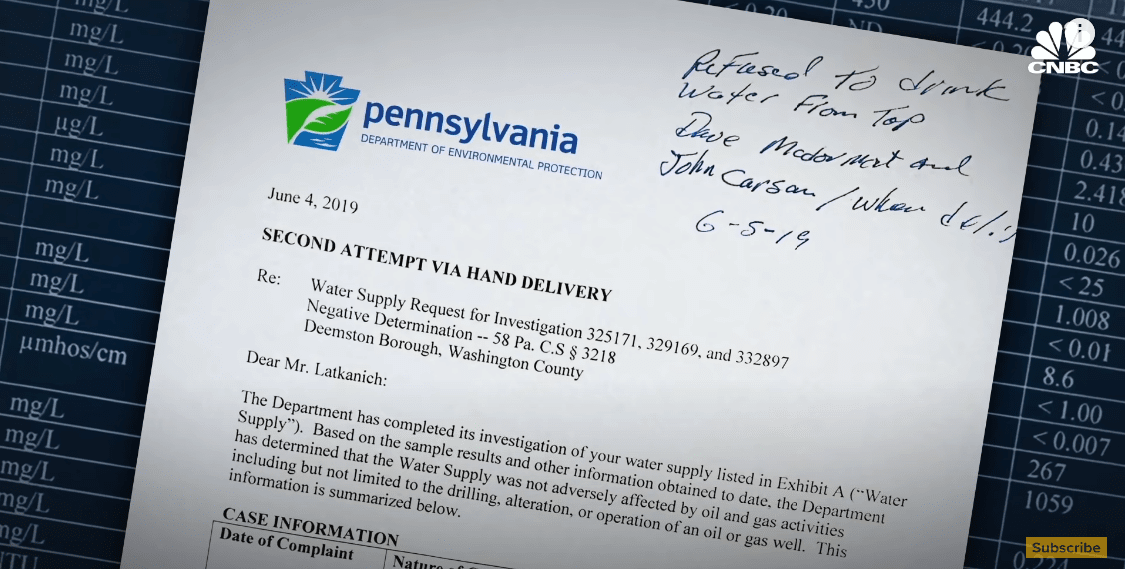
The Pennsylvania Department of Environmental Protection, which received complaints, did nothing. They concluded that fracking had no impact on the local water supply. This agency is entirely corrupt. They may as well not exist.

You can submit a report to the Pennsylvania Department of Environmental Protection, but they don’t care if they do. They will create a report that says nothing happened.
The Pennsylvania Department of Environmental Protection Would Like Reports — So They Can Pretend to Investigate Them
The Pennsylvania Department of Environmental Protection needs people to report things so they can justify their yearly budget. However, as they don’t spend time investigating things, and many of the employees are just there temporarily before they look for jobs in the industry, reporting things to the Pennsylvania Department of Environmental Protection is just for the benefit of the employees of the department, not for the people reporting the issues to the department.
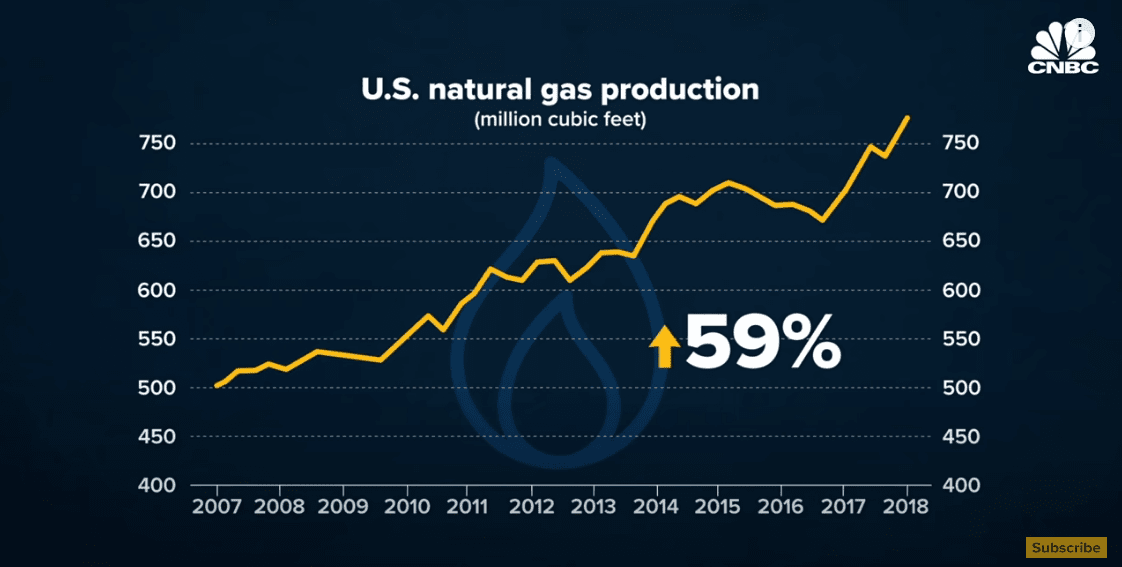
This graphic from the NBC video shows a massive increase in natural gas production.
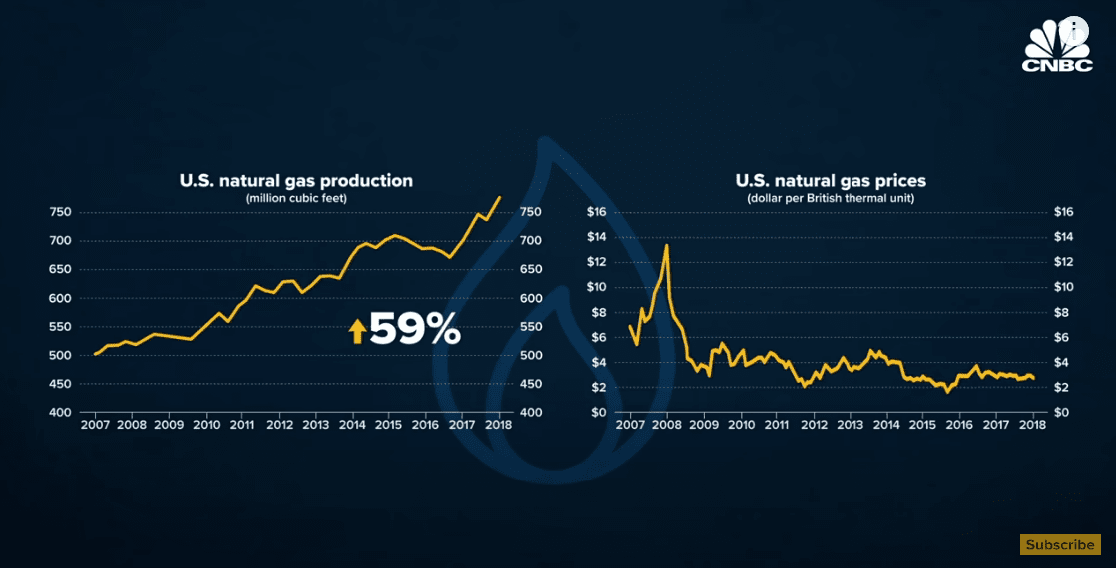
With a corresponding negative impact on the price, which impacted the economics of very expensive extraction techniques such as fracking.
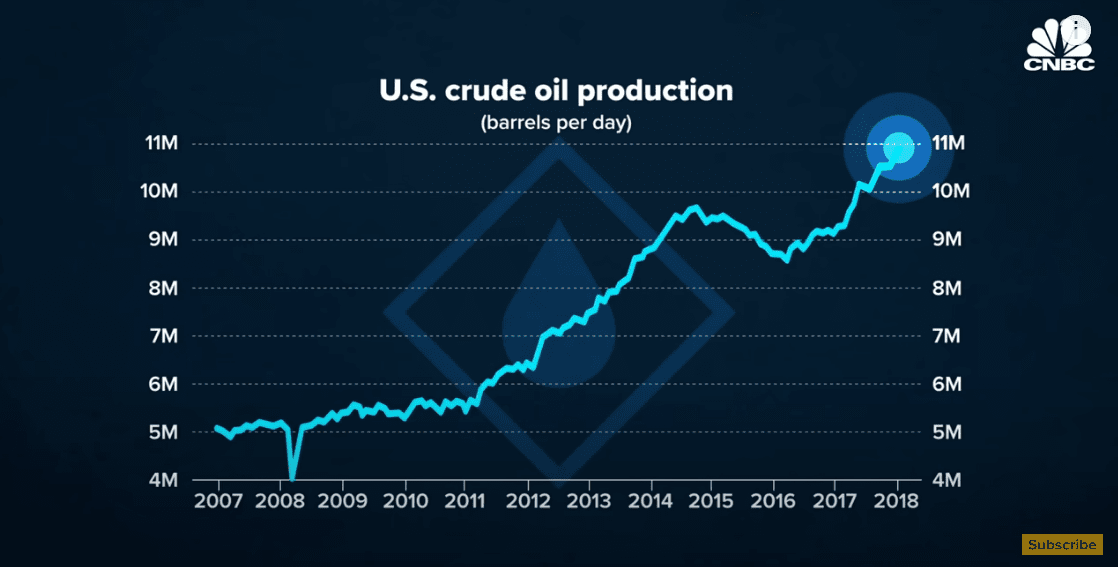
Crude production showed the same increase.
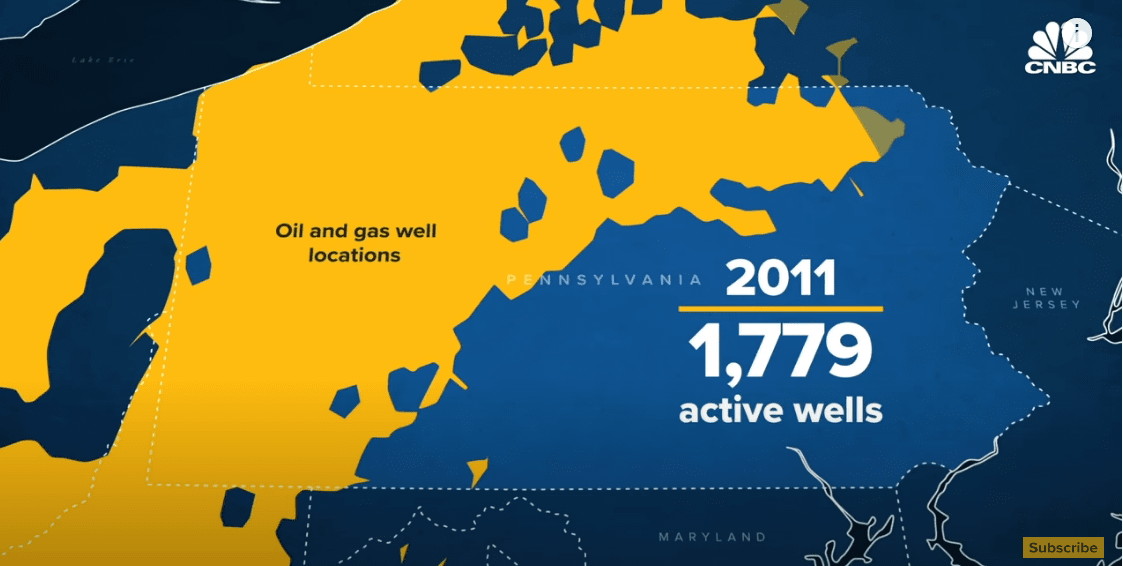
The number of wells required to be drilled by fracking is enormous because fracked wells quickly go dry. This is the fracking “treadmill,” where wells must be constantly drilled to compensate for drying wells.
The Reality of Fracking
Fracking has been known to have a negative energy return for some time. This was covered in several books, including Richard Heinberg’s Snake Oil: How Fracking’s False Promise of Plenty Imperils Our Future.
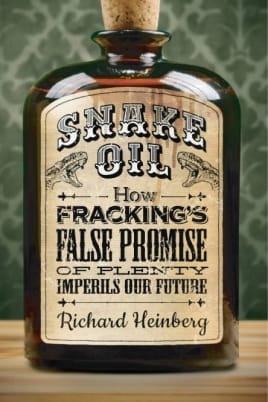
However, along with this book, there have been many books written by those with a financial bias that repeated the fracking industry’s false claims.
Here are some critical quotes from the book.
While on the campaign trail then candidate Donald Trump began to talk about energy independence. Upon election he installed one of the most energy heavy cabinets in modern history from Exxon Mobil CEO Rex Tillerson and Secretary of State to former Oklahoma Attorney General Scott Pruitt as head of the Environmental Protection Agency which he had sued. More than a dozen times to protect the interests of energy companies to former oil and gas consultant Ryan’s Inky, as Secretary of the Interior. Before his death, Aubrey McClendon had made a $10,000 donation to a PAC formed by Pruitt, who was then the Oklahoma, Attorney General to raise money for other candidates according to Oklahoma watch, which is sometimes a mark of someone with ambitions for higher office. After the election Donald Trump upped the ante in May he promised complete independence from foreign oil sources, saying, quote, imagine a world in which our foes and the oil cartels can no longer use energy as a weapon, wouldn’t that be nice and quote. In June, he took it a step further saying to a group gathered at the Department of Energy for an event called quote unleashing American energy, unquote. Call. We are really in the driver’s seat. And you know what, we don’t want to let other countries take away our sovereignty and tell us what to do and how to do it that’s not going to happen. With these incredible resources, my administration will see not only American energy independence that we’ve been looking for us for so long, but American energy dominance, unquote.

This is a nice picture of the city, but Oklahoma, naturally residing in Oklahoma City, is a hellhole. Scott Pruitt is a Cro-Magnon but with a law degree. Oklahoma City represents a sick society that cares nothing for the environment.
I have been to Oklahoma City several times, and I am trying to get out of the city as soon as possible each time. Driving through, I would contact family members to describe its offputting, strident, anti-environmentalist mentality and design.
The city is designed as if the rich don’t care about the city at all. And now it turns out that this is the base for Chesapeake Energy. A company that violated every environmental rule they could and a symptom of a terrible industry that cared about nothing but executive compensation.

And Scott Pruitt, the former corrupt AG of Oklahoma City, was installed as the head of the EPA, where he did tremendous damage before being removed for corruption.
This appointment by Trump is the proverbial wolf watching the henhouse. This shows Trump’s complete disregard for the environment.
How Bad is Oklahoma City? Not So Bad?

This is part of Oklahoma’s damage control messaging.
And Oklahoma City’s lack of governance has implications for the health of its citizens.
Oklahoma City was ranked the unhealthiest city out of the 50 most populous cities in the U.S. by health and wellness platform Mindbody.
The study surveyed 20,000 adults in the country’s most populated cities about their physical, mental and social well-being to create the ranking.
Oklahoma City was ranked as the most sleep-deprived, with only 38 percent of residents saying they get a full night’s sleep. According to the study, Miami was ranked as the healthiest and most well-rested city, with 62 percent of its residents getting a full night’s sleep. – OUDaily
And this study left out the concentration of pollutants in the bodies of those in Oklahoma City!
Bush, Obama, and Trump Administration All Buy the False Fracking Industry Talking Points
Here is Obama pushing the energy independence message. The rise in US oil production was primarily due to fracking, and none of it was done in a “safe, responsible way,” with tiny fines given out by Obama’s EPA for even the most egregious violations. Obama continued his policy of defending oil companies with his kid-glove treatment of BP during the Deepwater Horizon disaster, helping BP cover up the spill and allowing massive exemptions for the use of the highly toxic dispersant Corexit.
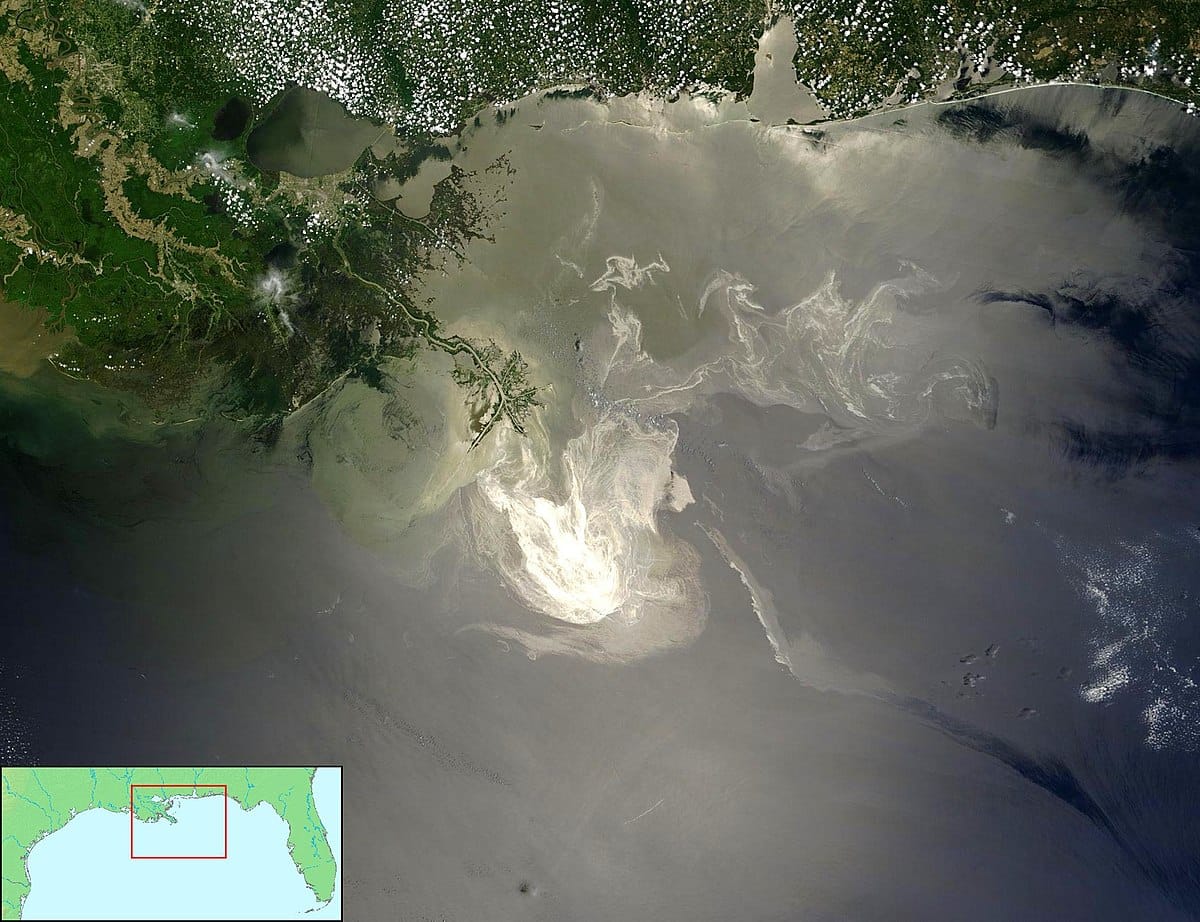
Perhaps because the US military “does not have any satellites,” Obama may not have been aware of how large the spill was?
Both the Trump administration and the Obama administration took essentially the same approach to fracking. They bought the industry’s proposals, about the opportunities from fracking hook line and sinker and used messaging around oil independence that had been proposed by the industry in their major speeches to the public. These speeches left out the environmental considerations.
While on the campaign trail then candidate Donald Trump began to talk about energy independence. Upon election he installed one of the most energy heavy cabinets in modern history from Exxon Mobil CEO Rex Tillerson and Secretary of State to former Oklahoma Attorney General Scott Pruitt as head of the Environmental Protection Agency which he had sued. More than a dozen times to protect the interests of energy companies to former oil and gas consultant Ryan’s Inky, as Secretary of the Interior. Before his death, Aubrey McClendon had made a $10,000 donation to a PAC formed by Pruitt, who was then the Oklahoma, Attorney General to raise money for other candidates according to Oklahoma watch, which is sometimes a mark of someone with ambitions for higher office. After the election Donald Trump upped the ante in May he promised complete independence from foreign oil sources,(emphasis added) saying, “imagine a world in which our foes and the oil cartels can no longer use energy as a weapon, wouldn’t that be nice?” In June, he took it a step further saying to a group gathered at the Department of Energy for an event called “Unleashing American energy. We are really in the driver’s seat. And you know what, we don’t want to let other countries take away our sovereignty and tell us what to do and how to do it that’s not going to happen. With these incredible resources, my administration will see not only American energy independence that we’ve been looking for us for so long, but American energy dominance.”
This illustrates that Trump liked the energy independence message and did not seek or listen to non-financially biased opinions on this topic.
Larry Summers Chimes In
With the enormous IQ, Larry Summers also jumped on the framing bandwagon, as the following quote illustrates.
Larry Summers, for his part told an audience at the Brookings Institution, “The merits are as clear as the merits, with respect to any significant public policy issue that I have ever encountered.”
Leon Panetta Chimes In
Leon Panetta co authored a 2015 Wall Street Journal op ed with Stephen Hadley, who had served at the national security as a national security adviser under President George W Bush in which they argued “the US remains the great arsenal of democracy and it should be the great arsenal of energy.”
The Discrepancy of Chesapeake Energy Between Reporting to the SEC Versus Investors
Companies are required to report their reserves to the Securities and Exchange Commission, but the numbers they report are based on an SEC formula that tries to ascertain, how much of the oil and gas in the ground would be profitable to drill. One investor analyzed 73 shale drillers in 2014 and found that almost all of them reported higher oil and gas prospects to investors than they did to the SEC. For instance, Chesapeake reported 2.7 billion in barrels of oil equivalent, a measure that equates natural gas with oil to the SEC. But 13 point 4 billion to investors. Pioneer reported 845 million barrels of oil to the SEC and 11 billion barrels of oil to investors.
The Swift Decline of Fracked Wells
A key reason for the terrible financial results is that fracked oil wells in particular show an incredibly steep decline rate. According to an analysis by the Kansas City Federal Reserve, the average well in the Bakken declines 69% in the first year and more than 85% in the first three years. While convention a well might decline by 10%, a year. One energy analysts calculated that to maintain production of 1 million barrels a day shale requires up to 2500 wells, while production in Iraq can do it with fewer than 100 for a fracking operation to show growth requires huge investment each year to offset the decline from the previous year as well as to Einhorn. This was clearly a vicious cycle.
The Effort Required to Frack
As soon as you’ve opened the tap and started production from your new oil or gas Well, you will also rehabilitate as best you can. Most of the land around the drilling site, if it’s a gas well a fenced area the size of a large was several pipes protruding from about three feet from the ground. Along the way, you’ll have to move a lot of equipment water and chemicals, all together. Each well will have generated 1800 to 2600 wheel vehicle trips.
Hiring personnel and renting drilling rig renting the drilling rig paying for the leaves hiring trucks. All this is expensive. By the time you turn on the tap you will have invested 10 to 20 million in your well pad, which, if you’ve been drilling for gas may produce only six to 15 million worth of product over its lifetime at today’s prices. If it’s an oil well you are more likely to show a profit although there is no guarantee.
Typical Lies From a Harvard-Affiliated Author
The industry’s PR efforts received an enormous boost from Leonardo Maugeri senior manager for the Italian oil company and senior fellow at Harvard University who published a seemingly authoritative paper. In June, 2012, titled Oil The Next Revolution. Leonardo Maugeri claimed that the shale tight oil boom in the United States is not a temporary bubble. But the most important revolution in the oil sector in decades
margaritas report received uncritical notice in major media outlets including the New York Times, The Wall Street Journal, NPR, and most broadcast and cable news television networks, and his assertions became common wisdom. This happened despite the presence of several pivotal and fairly obvious errors in the report, including Leonardo Maugeri’s consistent confusion of depletion rate with decline rate, a serious underestimation of decline rates from existing oil fields, and a simple but decisive math mistake and compound declines. It turns out that the reported not been peer-reviewed or even completely fact checked. Oil the Next Revolution was thoroughly debunked by experts, but none of the criticisms surface in the publications, then it turned the report into headline news.(emphasis added) It wasn’t hard to see why my Gary’s twisted tune was music to the ears of the oil industry.
We Will Never Run Out of Oil?
During the past year article after article in the mainstream press has gushed over the prospects for American oil independence and natural gas exports while ignoring the context, which is an ever increasing requirement for the investment of capital and energy in the extraction of fast depleting, and often poor quality fuels the media’s euphoria was perhaps epitomized by Charles Mann’s lead article in the May 2013 issue of the Atlantic titled, What If We Never Run Out of Oil. The magazine cover proclaimed in tall capital letters. We will never run out of oil, which of course is true the Earth’s crust will always contain immense amounts of crude, it’s just that we won’t be able to afford to extract most of it because doing so will either take too much money or too much energy or both. Continuing the theme the article subtitle asks a startling question what if fossil fuels are not finite, which implies uncertainty as to whether the earth is a bounded sphere or a plane extended extending endlessly in four directions.
The Effect on Local Governments and Communities
Pennsylvania research has also found that many of the new jobs, go to skilled out of state workers who fly in drill and fly home. The jobs for locals generated by fracking typically last for only about two to three years. All of this should be fairly predictable and unsurprising historically regions that rely on resource extraction as an economic pillar often underperform when compared to other regions, especially when viewed over the long term, more wealth is typically created in places that use energy and minerals from manufacturing and trade than in ones where resources are mined. For example, coal areas in West Virginia continue to be pockets of poverty despite decades of mining activity, the long term jobs created they are often paid little and the other industries including agriculture are driven out by the ensuing environmental damage. In both Pennsylvania and New York drilling companies are moving into the poorest counties first, and not just because that’s where the shale resources are located economically struggling areas are often targeted because the locals are less likely to engage in anti-fracking activism. People who desperately need leasing money or temporary employment may be willing to overlook environmental damage, even if it impacts our own land and homes. And they can also be counted on to take the industry side when community disputes arise over air or water quality. Locally local governments benefit temporarily from increased tax revenues during drilling booms. But costs to repair road damage sometimes running into the millions of dollars may outweigh that short term bonus. In 2012, the state of Texas received about $3.6. billion in severance taxes from all the oil and gas produced in the state from conventional wells, as well as those in fracked shale, but during the same year, the Texas Department of Transportation estimated damage to Texas roads from drilling operations at $4 billion, Arkansas is taking in roughly $180 million in severance taxes from since 2009, their costs with from road damage associated with drilling are estimated to be $400 and 500 million. Roads designed to last 20 years are requiring major repairs after only five years due to the constant stream of overweight vehicles ferrying equipment and water to and from fracking sites.
How The Financial Industry Drove Uneconomic Fracking
In a New York Times investigative article. After the boom in natural gas. October 20 2012 Clifford Krauss and Eric Lipton wrote a quote, like the recent credit bubble the boom and bust in gas were driven in large part by 10s of billions of dollars in creative financing engineered by investment banks like Goldman Sachs Barclays and Jefferies and company, unquote. The article details how this creative financing forced drillers to keep drilling, even when each new well representative financial loss.
In order for a publicly traded oil and gas company to grow extensively, it must manage not only its core business but also the relationship and enjoys with its investment bankers, thus publicly trading oil and gas companies have essentially two sets of economics, there is what may be called field economics which addresses the basic day to day operations of the company. And what is actually occurring out in the field? With regard to well costs production history, etc. The other set is Wall Street or street economics. This entails keeping a company attracted to financial analysts and investors so that the share price moves up and access to capital markets is assured. It was street economics rather than field economics that drove the gas glut, and price route, according to Rogers, who notes that the price decline, quote, opened the door for significant transactional deals worth billions of dollars and thereby securing further large fees for the investment banks involved in fact shales became one of the largest profit centers within these banks and their energy. m&a portfolio since 2010. She concludes that the glut was engineered in large measure, quote, in order to meet financial analysts production targets and to provide cash flow to support operations have imprudent leverage positions, unquote.
What Faces Civilization in the Future
Millions of farmers who are traditionally society’s primary energy producers were freed up to become factory worker salespeople and computer technicians perhaps even hedge fund managers or journalists. During this time labor productivity soared, not because people were working longer or harder but because they were using more energy at their jobs. By way of machinery to generate more wealth. Urbanization globalization specialization rapid economic growth, none of these would have been possible without increasing flows of energy. That was spectacularly cheap in both monetary in energy terms. Lower the overall er UI I have the energy system of a modern industrial society and the predictable result is a requirement for more investment in the energy sector and for more workers there as well. Over economic growth slows stalls or even reverses jobs and non-energy sectors disappear, globalization falters meanwhile more expensive energy translates to a stagnation or even decline in worker productivity. This is exactly what we’re beginning to see.
The Reality of Declining Yields
Paul’s finding is based on numerous recent studies, this pattern of declining, quote, this pattern of declining EROEI (Energy Return on Energy Investment). He writes, “was found for US oil and gas Norwegian oil and gas Chinese oil, California, oil Gulf of Mexico oil and gas, Pennsylvania gas, and Canadian gas.” A few energy financial analysts have explored the implications of EROEI often without observing Hall’s methodological rigor and without properly citing his original work in the field. Andrew Lee’s UBS writing in the Gathering Storm has argued that global EROEI is currently about 20 to one deriving this figure from energies, four to 5% of the world’s GDP. Given recent trends Lee’s calculates that the ratio might fall to 5.1 over the next decade, which could translate into a massive disruption of the world economy.
This book was published in 2013, back when nearly all the information about fracking getting to the public was pro-fracking. At that time, the only issue I can recall being raised was the environmental damage attributable to fracking. This is added to what has been learned about fracking, in that even if the environmental damage of fracking’s impact on the direct environment where fracking occurs (polluted groundwater, etc..), the greenhouse gas emissions are worse than coal.
New studies suggest that because of fugitive emissions of methane from wellheads and pipelines, natural gas may actually be no better than coal when it comes to global warming. “I was an early optimist about natural gas,” says Robert Kennedy Jr., who sits on a panel that’s advising Gov. Andrew Cuomo on whether to allow drillers like McClendon to expand into New York. “But after looking into it, I now believe that, without tighter regulations and stricter oversight, the shale-gas boom could turn out to be an economic and environmental disaster.” – Rolling Stone
The industry has completely disregarded the environment in an unlimited number of examples, but here is just one.
In the early days, gas producers did pretty much whatever they wanted with the billions of gallons of toxic water their operations produce. “Since there were no laws covering the disposal of this stuff at first, they just dumped it into rivers or hauled it off to sewage plants to be ‘treated,’ which they knew didn’t work,” says Deborah Goldberg, a lawyer at Earthjustice. “They just wanted to get rid of the stuff as quickly and as cheaply as possible.” At one fracking operation, a subcontractor was caught opening the valves on the back of his truck and dumping the wastewater on roads.
New laws in Pennsylvania now prohibit companies from discharging flowback into rivers and streams. Instead, operators like Chesapeake either “recycle” their water by running it through a filtration system, or haul it off to Ohio and inject it underground – a process which, some seismologists now suspect, is the reason Ohio was hit by an uncharacteristically large number of earthquakes last year. (The injected water lubricates fault lines, the theory goes, causing them to slip.)
scientists at Duke University, McClendon’s alma mater, published the first rigorous, peer-reviewed study of pollution at drilling and fracking operations. Examining 60 sites in New York and Pennsylvania, they found “systematic evidence for methane contamination” in household drinking water: – Rolling Stone
Now in 2020, when the fracking companies have run into financial trouble, it has begun to be publicized that fracking has an economic problem as well.
Documentary Gasland Had It Figured Out in 2010
The documentary Gasland, released in 2010, may have been one of the most accurate analyses of fracking.

Bethany McLean Strikes Again
Bethany McLean has an excellent track record. She was the reporter who called out Enron and pushed against the tide of innumerable media and investment analysts. Then, she published the book Saudi America, calling into question the economics of fracking in 2018 again, before the fracking bubble burst.
Here are some interesting quotes from her book.
On the foreign dependence of various countries on oil.
In 2013 Nigerian oil minister told CNBC that us shale oil was a quote grave concern, unquote. And no wonder industry publication hurt energy reported that as a result of the surge of shale oil. Several refiners had virtually eliminated their imports of Nigerian oil. The oil industry accounts for 70% of Nigeria’s tax revenue by summer of 2017, a as Nigeria plunged into its biggest economic crisis in years. Nigeria was begging for limitations on us shale oil.
A similar situation applies to Saudi Arabia.
McKenzie noted in the December 2015 15 analysis that Saudi Arabia gets around 90% of its government revenue from oil as oil prices soared from about $30 a barrel in 2003 to around. $110,000 a barrel from 2011 to 2012 says McKenzie Saudi Arabia’s GDP doubled, making it the world’s 19th largest economy by 2014 ahead of Switzerland and Sweden. The easy money of course encouraged high spending, according to the baker Institute of Public Policy public spending in Saudi Arabia tripled over the decade ending in 2014.
Flipping Leases
A big part of the fracking bubble has been the buying and selling of leases. This is covered in the following quotation.
According to Arthur Berman, a respected energy consultant in Texas who has spent years studying the industry, Chesapeake and its lesser competitors resemble a Ponzi scheme, overhyping the promise of shale gas in an effort to recoup their huge investments in leases and drilling. When the wells don’t pay off, the firms wind up scrambling to mask their financial troubles with convoluted off-book accounting methods. “This is an industry that is caught in the grip of magical thinking,” Berman says. “In fact, when you look at the level of debt some of these companies are carrying, and the questionable value of their gas reserves, there is a lot in common with the subprime mortgage market just before it melted down.” – Rolling Stone
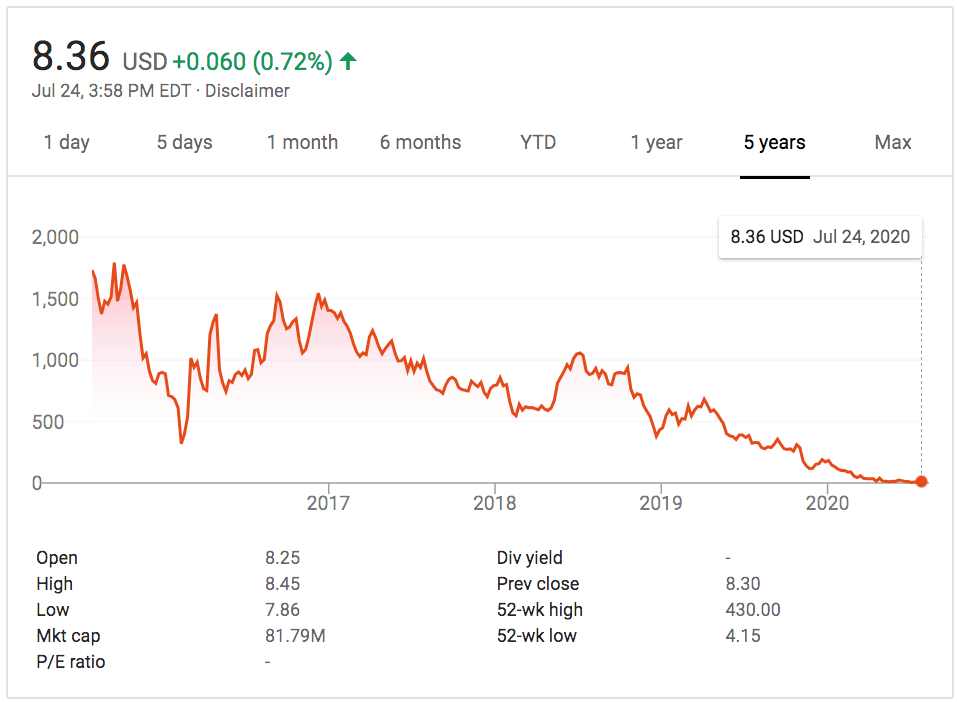
How did Chesapeake Energy’s stock price go from $1778 dollars to $7.26 in 4 years?
Some illustrative quotes from this book include the following.
Fracking Adds on A Negative Energy Return to a Horrible Environmental Record
The fracking industry is very well known for not caring about what they do to water supplies, and they have an EPA exemption for whatever garbage they pump into the ground. Fracking companies could publish what is in their fluid, but they keep it secret, and they have an exemption from reporting the contents of their fracking fluid from the EPA. Many people have described the fouling of their water supplies all around the country. This comment on the video is illustrative.
As someone living in Oklahoma where they are disposing the fracking fluid by pumping it into the ground I can tell you we need to stop this completely. Fir those who don’t know because the media isn’t covering it, because big oil cover-ups, we have been having many more earthquakes with them growing in strength. There are no major faults in Oklahoma and you can look on Google Maps anytime we have one of these earthquakes and look at the epicenter and a majority of the time you will find a fracking disposal site within a few hundred feet. Look at the earthquakes in Oklahoma from 2020 and you will see 3 basically stacked on top of each other at (36.351482, -97.356713) you will see large disposal well/site on the satellite images. This isn’t some conspiracy this is fact and its happening. – Comment
However, it is clear that fracking (on average) requires more energy input than it returns. This is the primary tenant of Peak Oil: the more that is extracted from wells, the more energy is required to extract future oil from the well. The industry has been in denial about Peak Oil for decades, but this fracking debacle once again proves the reality of Peak Oil.
Conclusion
Fracking was a loser initially, and regulators could have stopped it, but it wasn’t. So the US has allowed a highly destructive and economically infeasible sub-industry to pop up that will now have adverse severe financial implications for those that loaned money to the industry, not to mention the land that has been degraded by fracking.
As time has progressed, the information about fracking gets worse and worse, and the information provided by the fracking industry looks more and more like a con job. Some people knew the real story of fracking, but the US government chose not to listen to them.
Fracking is naturally environmentally damaging and should have been contested on these grounds, but the EPA is toothless. When Chesapeake Energy created an enormous spill, they were only fined $250,000. This illustrates how ineffective the government is in regulating the industry. However, the best move would have been to outlaw fracking.
References
https://www.amazon.com/Snake-Oil-Frackings-Promise-Imperils-ebook/
*https://www.amazon.com/dp/B07FSY6P3X/ref=dp-kindle-redirect?_encoding=UTF8&btkr=1
https://www.propublica.org/article/who-are-americas-top-10-gas-drillers
https://www.desmogblog.com/2020/03/05/us-shale-fracking-boom-fraud-alta-mesa-enron
*https://www.rollingstone.com/politics/politics-news/the-big-fracking-bubble-the-scam-behind-aubrey-mcclendons-gas-boom-231551/
*https://www.nakedcapitalism.com/2020/03/is-the-u-s-fracking-boom-based-on-fraud.html
https://en.wikipedia.org/wiki/Deepwater_Horizon_oil_spill
https://www.washingtonpost.com/climate-environment/2020/02/12/toxic-reach-deepwater-horizons-oil-spill-was-much-larger-deadlier-than-previous-estimates-new-study-says/
*https://www.counterpunch.org/2015/10/15/fracking-fraud/
http://www.oudaily.com/news/okc-tulsa-rank-among-unhealthiest-unhappiest-of-50-most-populous-cities/article_5ce6b4bc-3ed5-11ea-9a89-974f6d36c6c8.html
https://www.theatlantic.com/magazine/archive/2013/05/what-if-we-never-run-out-of-oil/309294/